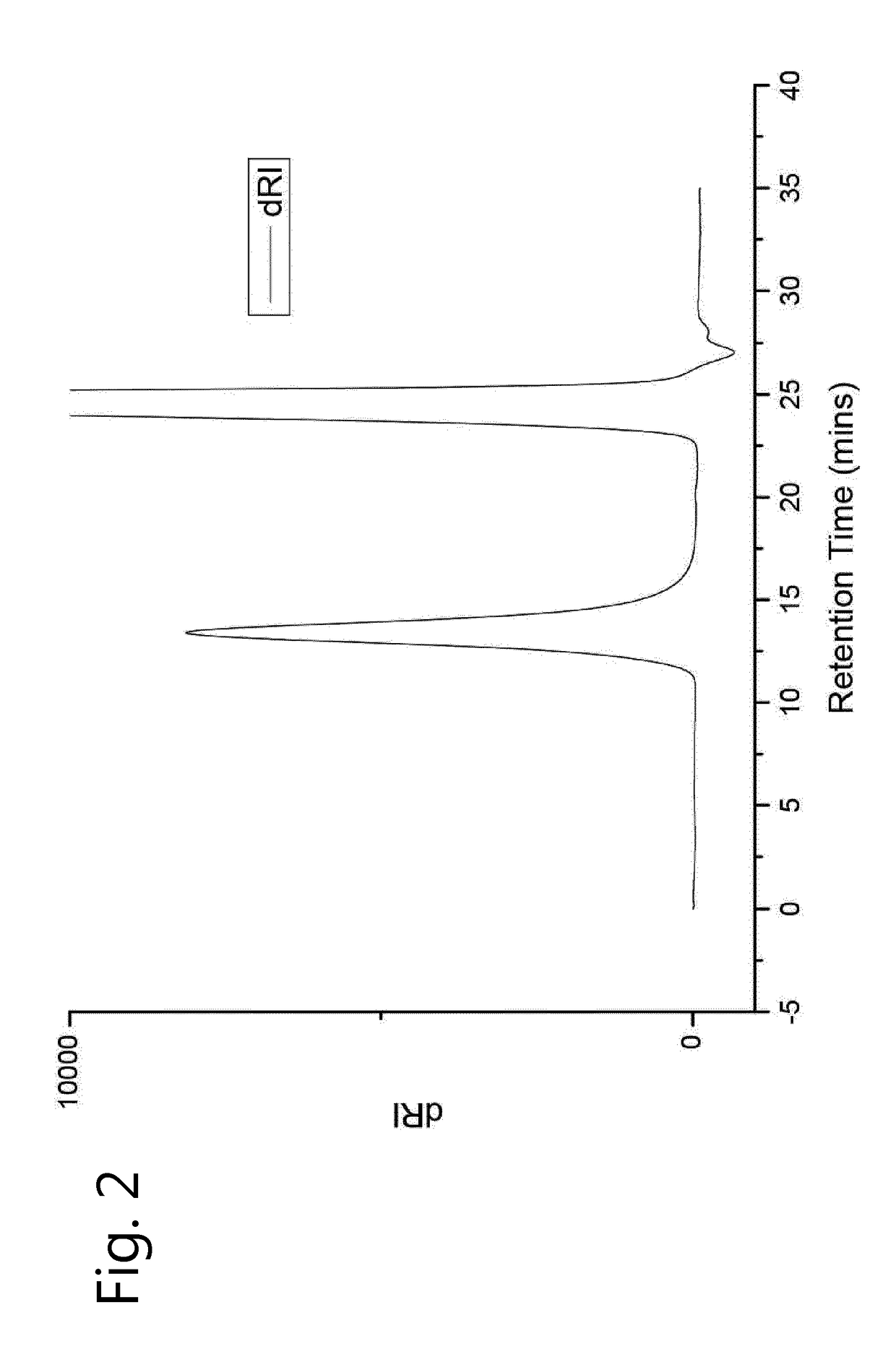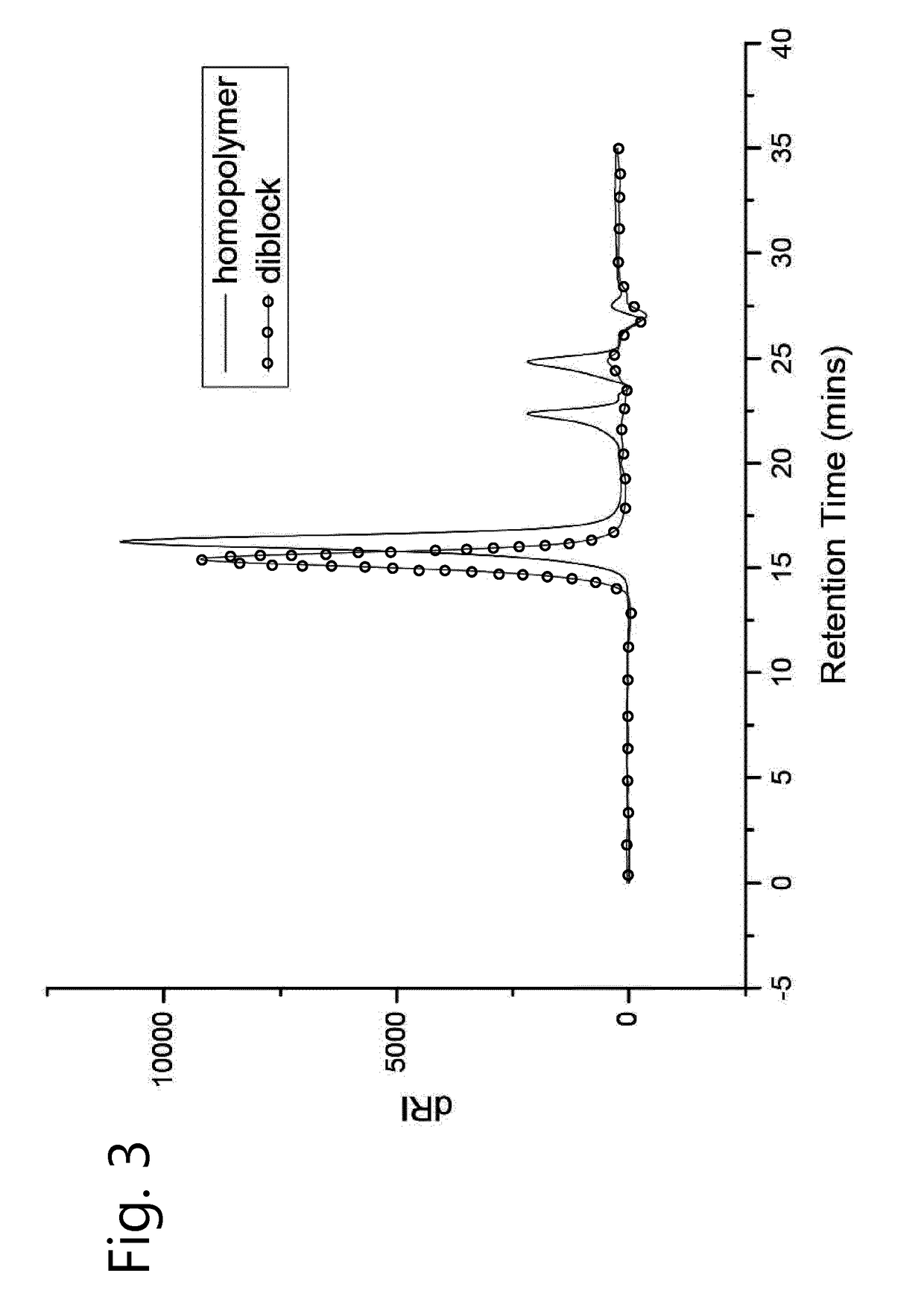Method for the preparation of uniform, high molar mass cyclic imino ether polymers
- Summary
- Abstract
- Description
- Claims
- Application Information
AI Technical Summary
Benefits of technology
Problems solved by technology
Method used
Image
Examples
example 1
[0114]Poly(2-ethyl-2-oxazoline) of 40 kDa nominal weight bearing a terminal amine group was prepared by polymerization to near quantitative conversion.
[0115]A reaction system was charged with 121.9 mg H.PhOx.BF4 into the cleaning vessel and 57.9 mg (246 μmols) H.PhOx.BF4 in the polymerization vessel. Chlorobenzene (20 mL) and 2-ethyl-2-oxazoline (10 mL, 99 mmols, M:I ratio=403) was syringed into the cleaning vessel against a counterflow of dry argon. The reaction mixture turned yellow immediately upon the dissolution of the crystalline initiator. After one hour of stirring the liquids were degassed and statically distilled into the polymerization vessel and sealed, with no colour developing in the polymerization vessel. The polymerization vessel was heated to 42° C. for 21 days, and then (after sampling) terminated with 7 N ammonia in methanol (1 mL) before precipitation in diethyl ether yielding 8.75 g (89% yield) of a white polymer, being poly(2-ethyl-2-oxazoline) bearing an amine...
example 2
[0118]A very high molecular weight (ca. 100 kDa) poly(2-ethyl-2-oxazoline) with a terminal amine was prepared as follows.
[0119]As per example 1, 95 mg H.PhOx.BF4 was placed in the cleaning vessel and 10.41 mg (44.3 μmols) in the polymerisation vessel. Chlorobenzene (20 mL) and 2-ethyl-2-oxazoline (10 mL, M:I=2,236) were added and the liquids handled as in Example 1. The polymerisation was regularly sampled and terminated at 74% conversion after 28 days at 42° C. Precipitation (3 rounds) yielded 5.10 g (70% yield) of a white polymer, being PEtOx bearing a terminal amino-group.
[0120]HFIP SEC revealed a monomodal peak as narrow as the PMMA standards used to calibrate the column as shown in FIG. 2.
[0121]SEC (eluent HFIP with KTFA): Mp=111,200 g / mol, Mn=94,100 g / mol, =1.02
example 3
[0122]Following the procedure of example 1, a series of PEtOx with different molecular masses was prepared and the results are summarized in Table 1. These were analysed by online viscometry and a correction factor of 0.777 was determined for HFIP. The eluting peaks in HFIP were truly poisson resembling the width of the PMMA standards.
NominalMp (UniversalMWCalibration)Mp (HFIP) (HFIP)10 kDa14,55610,8001.0320 kDa21,30818,6001.0330 kDa29,26729,3001.0340 kDa43,89944,4001.0250 kDa62,01156,7001.0270 kDa6628983,6151.03110 kDa 106,286143,0421.02
PUM
| Property | Measurement | Unit |
|---|---|---|
| Fraction | aaaaa | aaaaa |
| Degree of polymerization | aaaaa | aaaaa |
| Dispersity | aaaaa | aaaaa |
Abstract
Description
Claims
Application Information
 Login to View More
Login to View More - R&D
- Intellectual Property
- Life Sciences
- Materials
- Tech Scout
- Unparalleled Data Quality
- Higher Quality Content
- 60% Fewer Hallucinations
Browse by: Latest US Patents, China's latest patents, Technical Efficacy Thesaurus, Application Domain, Technology Topic, Popular Technical Reports.
© 2025 PatSnap. All rights reserved.Legal|Privacy policy|Modern Slavery Act Transparency Statement|Sitemap|About US| Contact US: help@patsnap.com



